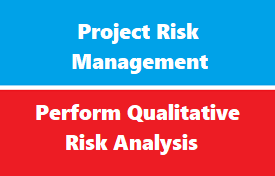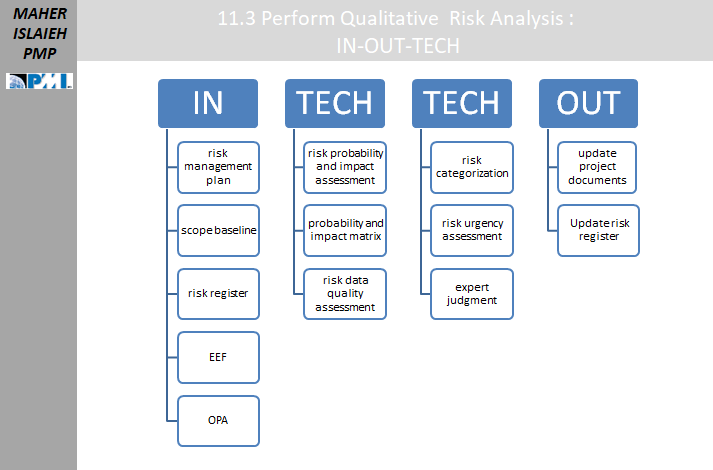introduction
Perform Qualitative Risk Analysis is the process of prioritizing risks for further analysis or action by assessing and combining their probability of occurrence and impact.
The key benefit of this process is that it enables project managers to reduce the level of uncertainty and to focus on high-priority risks
Concepts
- qualitative analysis is subjective analysis
- qualitative risk analysis : will compare risk to other risks in project for rating purpose
- qualitative analysis lead to create short list of high priority risk to be more analyzed in quantitative analysis and to plan response for this risk , the remain low priority risks will be put at watching list
- A risk rating matrix is developed by a department or a company to provide a standard method for evaluating risks. This improves the quality of the rating for all projects. It should not be changed, as this would make it impossible to compare the risk of one project to another.
- risk data quality assessment : evaluate the degree of which the data about risk is useful for risk management
- risk categorization : categorization risk by source like WBS , HR , cost , quality
qualitative risk analysis Steps
qualitative risk analysis include the following 5 Steps :
Put together a team to identify risks.
- It’s crucial to assemble a team of subject matter experts that bring direct knowledge and experience to help project managers isolate potential trouble spots.
Isolate all potential risks.
- What may seem like a minor risk can quickly expand to become a significant concern.
- Avoid assuming that some threats don’t need to be considered. It’s better to document all risks, then analyze and assign a weighting that can be re-evaluated later.
Rate and prioritize each risk
- Based on its impact and likelihood of occurring, each risk should be rated to determine if it’s a high priority or low concern.
Develop strategies to address risks based on their priority.
- After setting the priority for each risk, work with subject matter experts to come up with potential strategies to address them.
- Make sure to think about the impact of each solution on other risks and solutions.
Monitor each risk and re-evaluate.
- It’s not enough to identify risks and come up with solutions. Often, as a project is progressing, risks, their impact, and the likelihood of occurring can change. Revisit risks as each crops up and is addressed.
Probability and Impact Assessment
Probability and Impact Assessment
Likelihood = Probability
Consequences = Impact
Qualitative Risk Analysis involves the estimation of the likelihood and consequences of each risk
Quantitative Risk Analysis involves estimating the measurable impact on project objectives, specifically – Cost, Time, Scope and Quality
process Inputs - Techniques - Outputs
Inputs
- risk management plan
- scope baseline
- risk register
- EEF
- OPA
Techniques
- risk probability and impact assessment
- probability and impact matrix
- risk data quality assessment
- risk categorization
- risk urgency assessment
- expert judgment
Outputs
- update project documents
- Update risk register
Process Inputs
Perform Qualitative Risk Analysis: Inputs
Project Management Plan
the following elements are of particular interest to this process.
- Roles and responsibilities–who is the lead of the risk management team and who are the team members? Who will support the activities within the organization? What are the specific responsibilities of each member of the team?
- Schedule–defines when and how often risk management processes will be performed throughout the project life cycle, and establishes those risk management activities that will be included into the project schedule., including those related to this process of qualitative risk analysis.
- Budget–gives the budget for risk management activities that will be included into the project budget, including those related to this process of qualitative risk analysis.
- Risk categories–a risk breakdown structure or RBS is a representation of potential sources of risk on a project. Creating an RBS helps the project team consider the full range of sources from which individual project risks may arise.
- Definitions of risk probability and impact–the probability and impact matrix divides these concepts into qualitative thresholds like “low”, “medium” and “high”. The definition of these thresholds is important to establish at the beginning of the project.
- Stakeholder risk appetite–this should be expressed in terms of measurable risk thresholds around each project objective in order to determine the acceptable level of overall project risk exposure.
Project Documents
- Assumption log–this is the log you create to keep track of monitoring key assumptions and constraints that may affect the project. High-level strategic and operational assumptions and constraints are identified in the business case (a document prepared by business analysts) and are listed in the project charter. Lower-level assumptions related to individual activities and tasks are identified throughout the project, such as Technical specifications and Estimates (for both cost and schedule)
- The risk register, contain details of each identified individual project risk that will be assessed during the Perform Qualitative Risk Analysis process. Details regarding the probability and impact of each individual risk will be added to the risk register as a result of this process.
- Stakeholder register–this will include details of project stakeholders who may be nominated as risk owners. They will be consulted during this process to get their perceptions of the probability and impact of the risks they have been assigned.
Enterprise Environmental Factors
- Published material, including commercial risk databases or checklists, from similar projects.
Organizational Process Assets
- Information from similar completed projects done by the organization.
Process Techniques
Perform Qualitative Analysis: Tools and Techniques
Expert Judgment
- This is one of the “generic” techniques used in a lot of planning processes.
- It means asking for subject matter experts, in this case on the subject of qualitative risk analysis,
- to help your project team assess the probability and impacts of individual project risks.
- These are people who have either done a similar analysis before, and particularly those who have analyzed a similar project to the one currently being done by your organization.
Data Gathering
- Interviews with stakeholders are one way of assessing the probability and impact of individual project risks.
Data Analysis
- Risk probability and impact statement: risk probability is the likelihood that a specific risk will occur, and risk impact is the potential effect on one or more project objectives such as schedule, cost, quality or overall performance of scope.
- Although it is a qualitative analysis meaning that is based on the subjective impressions of people, it can be nonetheless quantified to a certain extent by giving a scale or range for the probability and/or impact.
- For example, you could use the following scheme to rate each risk from 1 to 5:
Very low (1)
Low (2)
Moderate (3)
High (4)
Very high (5)
Interpersonal and Team Skills
- technique used in conjunction with gathering data in many planning processes. Facilitation is like a group interview technique where participants focus on the risk analysis task and reach a consensus on assessments of probability and impact rather than just having individual interviews.
Risk Categorization
There is a tool called a Risk Breakdown Structure which helps categorize risks like :
- Technical risk
- Management risk
- Commercial risk
- External risk
Grouping risk into these categories can help in focusing on particular types of risk, and developing generic risk responses to address groups of risks related to the same source.
Data Representation
- Probability and impact matrix–this is a grid for mapping the probability and impact of each individual risk,
- Hierarchical charts–another possible form of data representation would be if there are three parameters,
Meetings
The meeting related to this process should include the following:
- Review of the list of previous identified risks
- Risk owner allocated to each individual project risk
- Reviewing the probability and impact scales to be used during the analysis
- Conducting an assessment of the probability and impact of the individual project risks and using probability/impact matrix to get combined rating
- Categorization and prioritization of risks based on combined probability/impact rating
- Identification of additional risks (to be added to the risk register)
process outputs
Perform Qualitative Risk Analysis: Outputs
Risk register
should include information on the following:
- Assessments of probability and impacts for each individual project risk
- The combined risk score and its priority level (very low, low, moderate, high, or very high)
- Risk urgency information and/or additional risk categorization
- Watch list for low-priority risks
Risk report
the risk report that goes out to all stakeholders concerned with risk should include the following:
- The most important individual projects risks with the highest probability/impact
- Prioritized list of all identified risks on the project
- Summary conclusion
Assumption log
- if during this process, new assumptions are made, or new constraints identified, these may be added to the assumption log
Issue log
- if during this process, any new issues are uncovered or any changes are made to the currently logged issues, the log is updated to reflect them


